The 5 Key Principles Of Event Design - Including Checklist
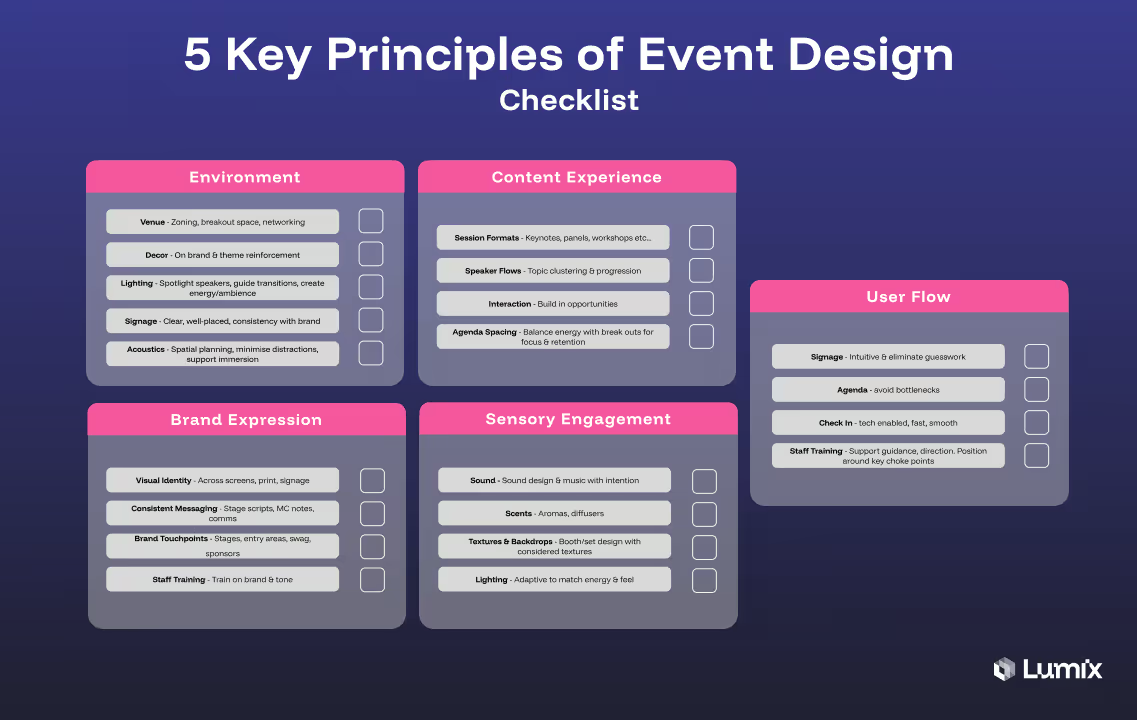
Weekly newsletter
80% of marketers say live events are critical to their company’s success. But turning that importance into impact isn’t easy, especially when audience expectations are rising and internal pressure to prove ROI keeps building.
As a CMO or event leader, you know the feeling well. You try to get all the logistics just right, the venue polished to perfection, and the speaker lineup carefully chosen. Still, the event doesn’t quite hit the mark. The energy drops too soon, conversations remain shallow, and the post-event engagement fails to spark.
This is often where event design comes in. Not just how the space looks, but how the experience is built from the ground up. Event design is the process of shaping every touchpoint to align with your goals and move your audience. It turns content into connection, and attendance into momentum.
In this guide, we explore what meaningful event design really involves, how the best teams approach it, and what you can do to raise the bar on your next conference or brand experience.
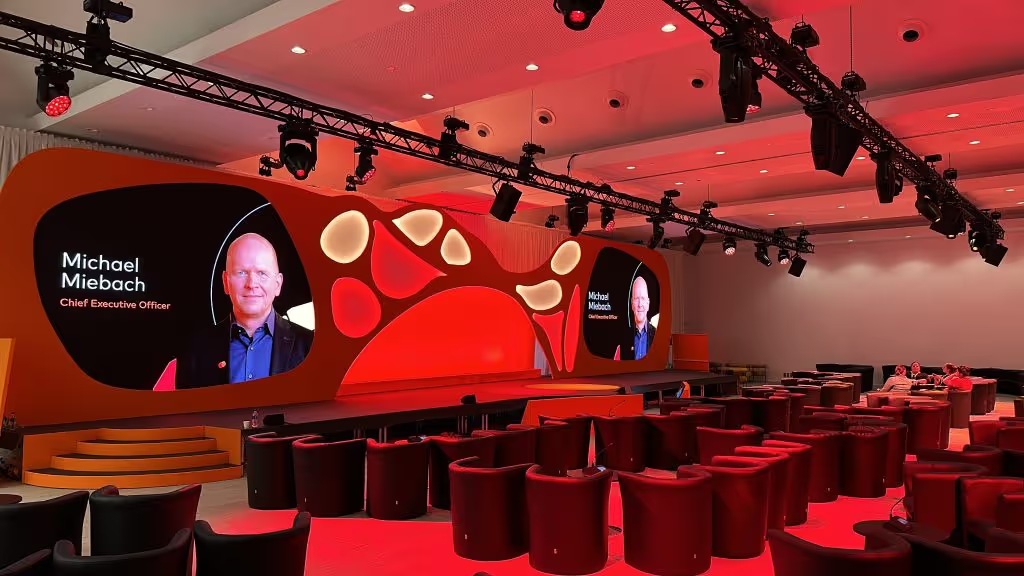
The Core Elements of Strategic Event Design
Event design includes what people see, hear, feel, and remember of an event. It means building an environment that reflects your brand, keeps attention, and moves people emotionally and physically.
The team behind Lumix Procurement have been operating in the events industry for over the last decade. They’ve planned everything from the biggest tech festival in Europe, music festivals, brand activations for the likes of Nike and conferences and summits across the globe. Regardless of the event these event design principles remain the same.
Here are the building blocks of strategic event design:
1. Environment
The setting shapes first impressions. A well-structured environment helps guests move with ease, stay focused, and feel like they’re part of something intentional. It sets the tone for everything that follows.
We’ve worked with hundreds of event leads, and we’ve seen firsthand how challenging it can be to get the environment right, especially at scale. However, with the right suppliers, floor plans, and design strategy, CMOs and event leaders can craft a strong and positive space. It anchors the experience and supports every other part of the event
Key elements:
- Venue layout and zoning for key activities like registration, breakouts, and networking
- Decor that reinforces your theme, without overwhelming the space
- Lighting design to manage energy, spotlight speakers, and guide transitions
- On-site signage that’s clear, well-placed, and consistent with your brand
- Acoustics and spatial planning that minimise distractions and support immersion
2. Content Experience
You already know great content is non-negotiable, but format and delivery determine whether it sticks with the audience. Designing sessions with intention makes it easier to keep attention high and create space for real interaction, not just passive listening.
Key elements:
- Defined session formats such as keynotes, panels, and hands-on workshops
- Speaker flow with intentional timing and topic progression
- Built-in opportunities for interaction
- Agenda spacing that balances high energy with breaks for focus and retention
3. Brand Expression
Your event is a living expression of your brand. From the moment attendees arrive, the visual and verbal cues they encounter shape how your business is perceived. Subtlety matters, and strong brand presence doesn’t mean plastering logos on every surface.
Key elements:
- Cohesive visual identity across digital screens, printed materials, and digital signage
- Consistent messaging tone across stage scripts, emcee notes, and comms
- Branded touchpoints like stages, entry areas, swag bags, or sponsor booths
- Staff trained to embody your brand tone
4. Sensory Engagement
Multisensory design is a proven way to increase emotional retention. By thinking beyond sight and sound, you create an immersive setting that attendees will remember long after the event ends.
Key elements:
- Purposeful sound design or music curation for energy and atmosphere
- Ambient scents with natural elements, diffusers, or branded aromas
- Engaging textures and backdrops that elevate the look and feel of the space
- Adaptive lighting and temperature to match the energy across sessions
5. User Flow
Even the best-planned event can fall flat if people don’t know where to go or how to move through the space. A well-structured user flow respects attendee time and reduces friction, especially when working with large spaces or tight schedules.
Key elements:
- Simple, intuitive signage that eliminates guesswork
- Agenda pacing that avoids bottlenecks between sessions or meals
- Fast, tech-enabled check-in and smooth on-site movement
- Staff trained to guide, direct, and support navigation at key choke points

How Today’s Best Events Are Being Designed
Event design has come a long way from basic stage setups and branded backdrops. Today’s conferences are immersive, multi-layered experiences, carefully designed to spark connection, deliver value, and leave a lasting impression.
We’re seeing companies like Microsoft use real-time collaboration tools and hybrid access to connect global audiences during Build and Inspire. Adyen’s Next focuses on tailored attendee journeys by segmenting audiences and adapting content, spaces, and flows. Companies like Salesforce are rethinking internal events too, focusing on emotional clarity and leadership impact over slide-heavy presentations.
Across the industry, the best-designed events today:
- Create environments that shift with the mood and pace of the day
- Offer breakout content that suits different learning preferences
- Use music, scent, and lighting to influence energy and focus
- Build in moments that are shareable, surprising, or deeply memorable
- Capture attendee behaviour and feed it into future event planning
Technology still plays a major role. Around 68.7% of event planners use it to elevate the experience. Augmented reality, AI-based networking, interactive displays, and live analytics are becoming common. But it’s the strategy behind the tech that defines its value.
Modern event design is less about one big moment and more about curating a complete, connected experience. The most forward-thinking teams use creativity and data in equal measure to shape what people walk away remembering.
Designing Across Event Types
Event design isn’t one-size-fits-all. The common principles remain, but how you apply them depends on the type of event. Different formats come with different challenges, audience expectations, and levers for impact.
Here’s how leading brands are tailoring their design strategies across the most common business event formats:
1. Conferences
Objective: Build authority, foster community, and sustain energy across multiple days.
Design Focus: Modular spaces, adaptive environments, and fluid transitions.
For conferences, the environment must support varied activities such as keynote sessions, workshops, and networking lounges, each requiring different spatial and sensory design.
When organising large-scale conferences, procuring flexible staging, modular furniture, and smart lighting systems from specialised suppliers helps tailor zones for focused learning and casual connection.
Example: At HubSpot’s INBOUND, the venue layout changes dynamically between sessions. They use movable partitions and branded pods to create intimate conversation areas, while large auditoriums are equipped with adjustable acoustics and lighting to match session energy.
2. Trade Shows and Expos
Objective: Showcase innovation, generate leads, and simplify navigation in high-density spaces.
Design Focus: Clear zoning, immersive booths, and sensory cues.
Trade shows are inherently busy and overwhelming, so spatial design must reduce decision fatigue and create standout moments. Procuring high-impact booth designers, lighting technicians, and interactive technology providers ensures exhibitors can tell their story effectively. Incorporating scent marketing or curated music playlists at strategic points can subtly guide attendee mood and movement.
Example: At CES, major exhibitors collaborate with specialised suppliers to build layered booth experiences designed with crowd flow and visual hierarchy in mind.
3. Internal Company Events (Town Halls, Kickoffs, Leadership Summits)
Objective: Align vision, energise teams, and foster belonging.
Design Focus: Emotional storytelling through space, light, and interaction.
Internal events demand environments that reflect company culture and values without overbranding. Supplier partnerships in stage design, lighting, and branded swag are crucial to create subtle but consistent brand reinforcement. Thoughtfully designed breakout areas with flexible seating and mood lighting can encourage open dialogue and peer connection.
Example: Salesforce’s internal events use impressive stage designs and changing lighting to tell a story throughout the event. They add special touches like custom-branded notebooks and interactive kiosks to improve engagement.
4. Product Launches and Brand Activations
Objective: Generate excitement, control narrative, and create memorable brand moments.
Design Focus: Dramatic staging, sensory storytelling, and shareability.
Launch events rely heavily on theatrical design and sensory engagement to build suspense and amplify brand messaging. Procuring innovative lighting rigs, projection mapping, and interactive installations can help you create a lasting impression. Even backstage and hospitality areas are designed to reflect brand values and sustain event energy.
Example: Apple’s product launches are known for great teamwork between different suppliers, like audiovisual experts and set designers. They carefully plan every lighting change, sound, and visual detail. This close supplier collaboration makes sure the brand story is clear and powerful at every part of the event.
The Challenges of Event Design and How to Overcome Them
Event design is often mistaken as being only about looks, but while aesthetics are essential, they are just one part of a much bigger picture.
For CMOs and event directors, the real challenge lies in making sure every design element supports the overall experience and meets business goals. This means balancing creative ideas with practical realities like budget limits, venue constraints, and the need to satisfy multiple stakeholders.
Managing these requires careful coordination and clear communication. One of the biggest struggles is finding reliable suppliers who deliver on time, within budget, and with the right quality. Misalignment between finance and marketing teams over procurement can add even more hurdles, slowing decision-making and increasing risk.
At Lumix, we understand these challenges well. Our platform offers trusted supplier recommendations and simplifies the procurement process so that marketing and finance teams stay in sync.
Early connection with the right partners ensures that every element of the event design comes together seamlessly. This approach reduces delays and stress while allowing you to design events that leave a lasting impression and stay true to your brand’s vision.
In Summary
Event design is a major chunk of what makes your event stand out. It goes beyond looks to craft an experience that truly connects with your audience and supports your business objectives. For CMOs and event directors, balancing creative vision with budget, supplier coordination, and cross-team alignment is no small feat.
Lumix recognises these challenges and offers a seamless platform to connect you with trusted suppliers and streamline procurement, keeping marketing and finance on the same page.
The Lumix team is happy to connect with you and help guide your next event from vision to reality with ease and confidence. Book a Demo!
Lumix Blogs
Get the indise scoop: the latest tips, tricks, & product updates
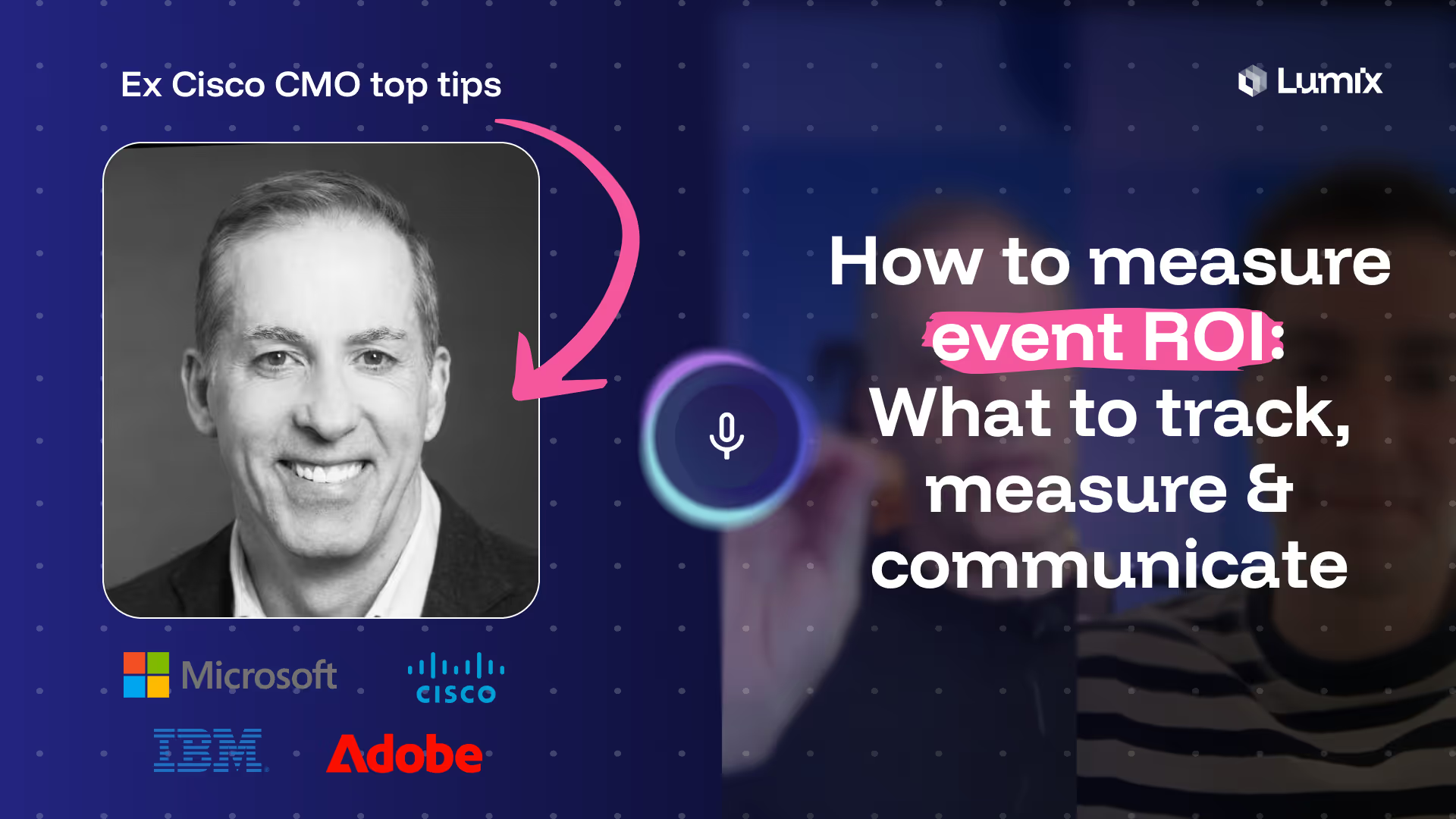
Proving Event ROI: How to Speak Finance’s Language with Insights from Mark Phibbs, ex-Adobe & Cisco CMO
“ROI isn’t just about counting heads at a booth, it’s about understanding how events accelerate pipeline, loyalty and revenue.”
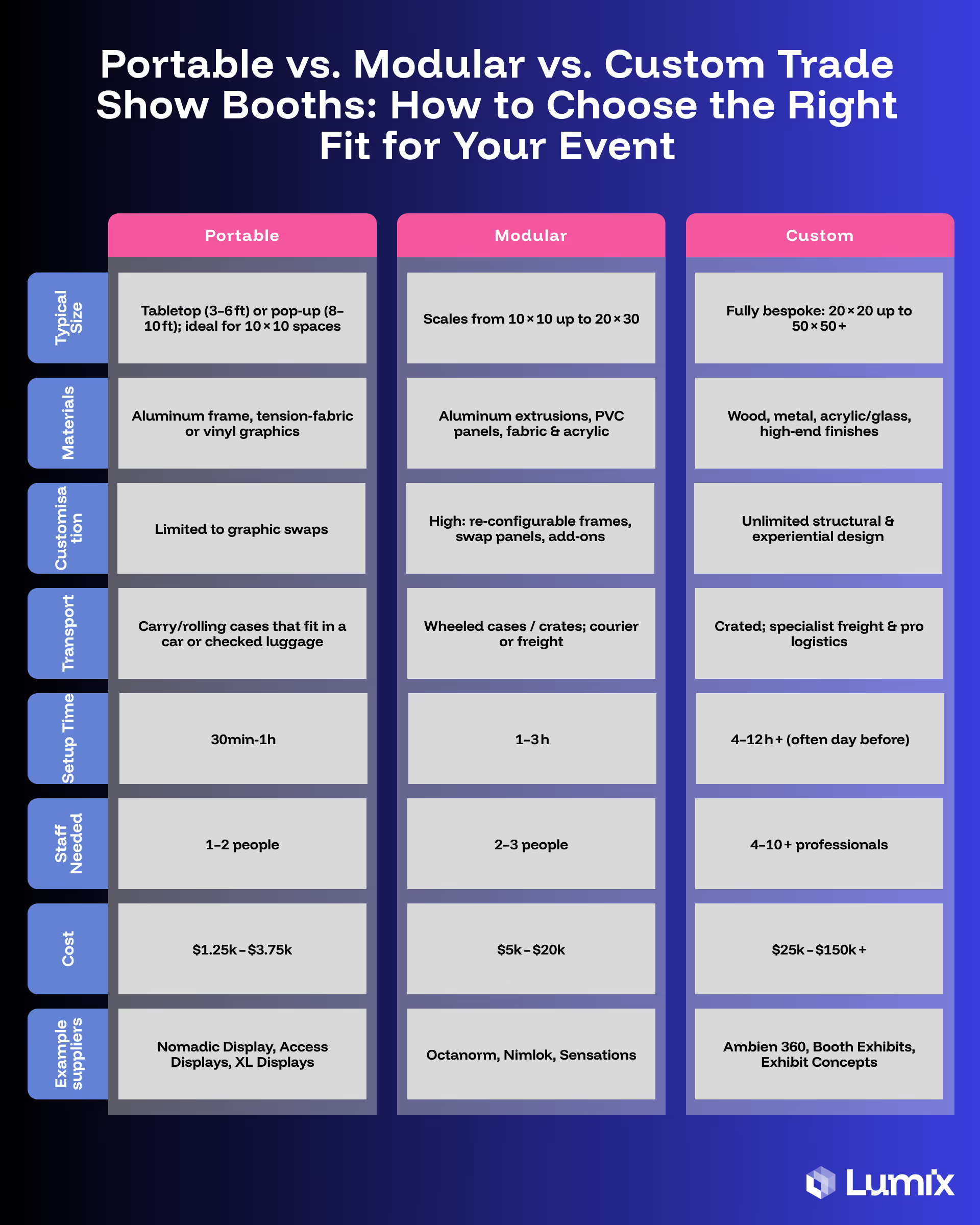
Portable vs Modular vs Custom Trade Show Booths: How to Choose the Right Fit for Your Event
Understand which booth set up is right for your next event
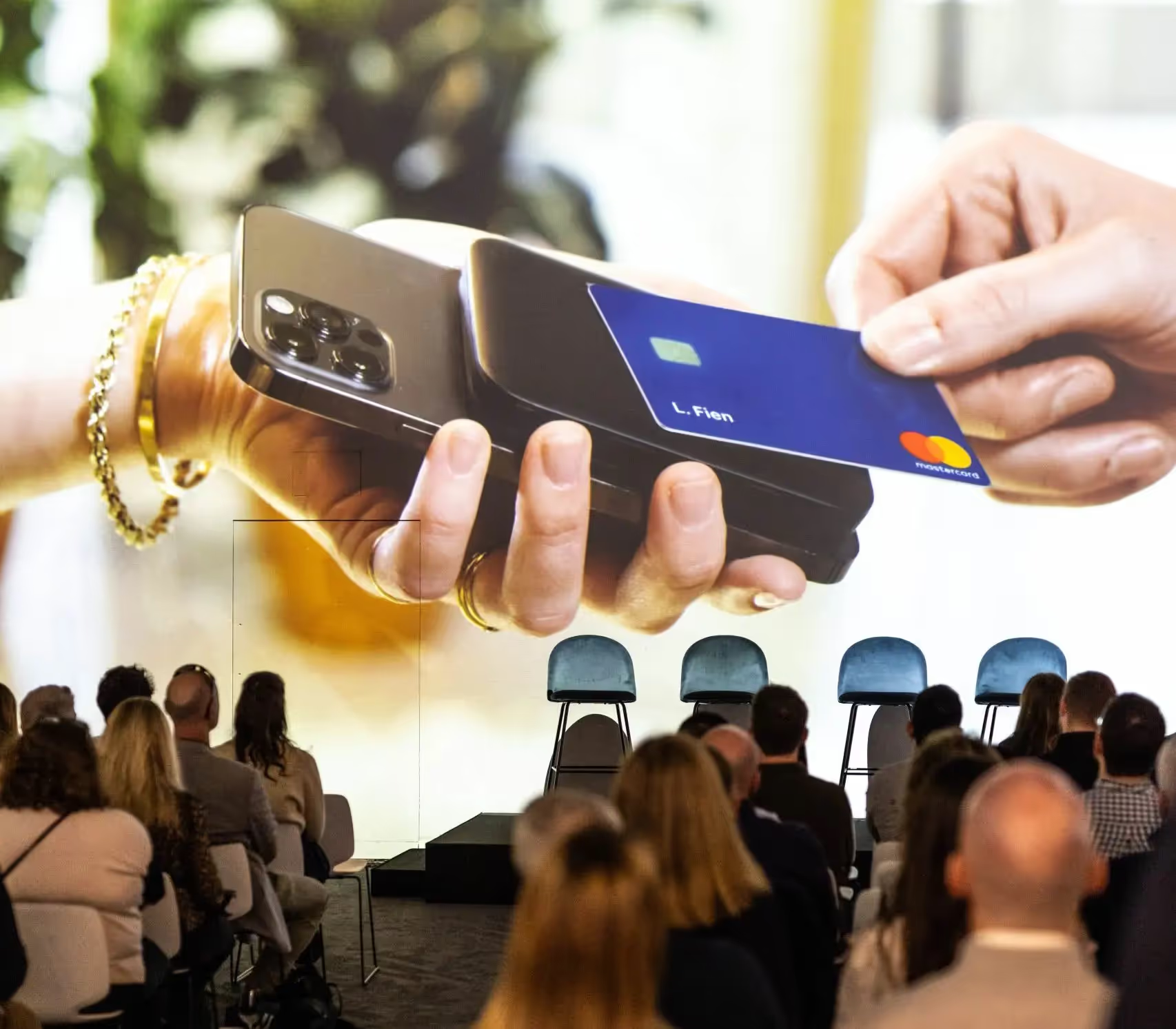
How To Organise A Large Scale Conference
Planning a large scale conference? Check out our handy guide
Frequently Asked Question
Have another question? Please contact our team!
Yes. The platform provides side-by-side quote comparisons that show what’s included (and what isn’t) in each proposal. You’ll see cost breakdowns, supplier notes, and Lumix’s benchmarked pricing insights all designed to help you make confident, data-driven decisions.
Yes. You can upload and store your existing brief templates, or use Lumix’s AI-assisted builder to generate new ones. The platform also learns from your past events, so future briefs can be created faster with pre-filled details and preferred suppliers.
Absolutely. Lumix is built for flexibility. You can update or amend briefs at any time through quote revisions. When you make changes, suppliers are automatically notified and can adjust their quotes accordingly, keeping everything transparent and version-controlled.
A Lumix-vetted supplier has been verified for legal identity, financial health, insurance, certifications, and recent performance. We don’t just check paperwork once — we continuously monitor suppliers’ live performance on the platform to ensure they meet professional, safety, and compliance standards.
Our vetting process happens in three levels: Verified: Baseline identity and compliance checks, legal registration, sanctions screening, insurance, and minimum financial health scores. Certified: Category-specific evidence such as food-hygiene, rigging, or data-security certifications, depending on the supplier’s role. Audited: For high-value or critical suppliers, we add deeper due diligence including third-party audits, ESG assessment, and verified delivery KPIs on Lumix.
Yes. We align our vetting standards with leading UK and global frameworks such as Achilles, Hellios FSQS/JOSCAR, Avetta, SafeContractor, and EcoVadis. Where appropriate, Lumix integrates or recognises these certifications within our supplier profiles to avoid duplicate checks.
